The Canal du Midi winds 240 kilometres through the vineyards of the Languedoc. For long stretches, you see nothing but vines between the plane trees. But you hardly ever - or only rarely - discover a winery. And only very few "caves" (wine cellars) present their wines along the canal.
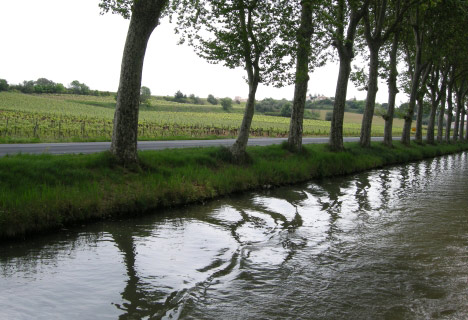 |
| Trip on the houseboat - past vines% vines% vines |
In the second-hand navigation book of friends that I use, there is a handwritten entry: "Luki, get wine, 3 litres of rosé!". In fact, you usually need at least a bicycle to get wine, or more likely a car, to get good wine.
Warned by these experiences, I prepared the trip on the Canal du Midi wine-wise. In Agde - our starting point for the trip up the canal to Carcassonne - selected wines are invited. Every day, at least one particularly good wine from the appellation we crossed or from the nearest appellation.
The toast with these - mostly internationally known - Languedoc wines is part of the highlight of the cosy, convivial evening after the day's trip. An experience - although only constructed in our heads - proved true day after day. After a lot of nature, wide landscape, endless vine fields and the smell of musty water, resin, the scent of flowers and forest, every wine tastes twice and three times as good as at home at the parlour table. I can swear to this because I have drunk all these wines many times and again at home.
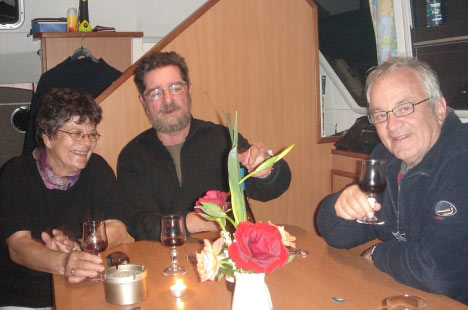 |
| Cosy wine round in the evening% after hours of driving through Languedoc |
The first stretch of our long drive, from Agde to well beyond Béziers, takes us through the AOC region of Coteaux du Languedoc. It is the largest appellation, not contiguous, rather scattered over a huge area. Of course, there are also outstanding wines here, but to find a certain character in them or even a special terroir is impossible.
We therefore start our wine round on the leisurely "wine tour" with a Faugères, from an appellation that we do not drive through, indeed cannot even see: Faugères lies about 40 km north of the canal, at an altitude of up to 400 m.a.s.l. On the canal we stay "down", where the plain approaches sea level.
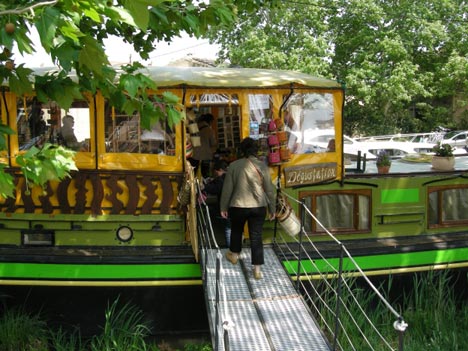 |
| The village shop on the boat: shopping and tasting |
Faugères: there are many excellent wines there, which are also internationally known and in demand. We are not opening an "international" Faugères, but a "traditional" Faugères, typical of an area where the winegrowers have to contend with an often harsh landscape, with a lot of drought, heat and wind, with a slate soil covered by a stone desert, and where yield reduction is also a verdict of nature. You can feel all this in the "Castel Fossibus" from Domaine Ollier-Taillefer. Depth, power, aromatics (spices, liquorice, red fruits), the typical hints of schiste (slate) - a wonderful wildness tamed in the wine, a wonderful contrast to our quiet trip on the canal.
After Béziers - with its marvels, the aqueduct we are travelling on and seven locks in a row - we approach the next famous wine region: St-Chinian. We only touch the appellation, but its southernmost (flat) part is in sight, perhaps two kilometres away. In the north of the appellation, the wines resemble those of Faugères, but in the south, the Mediterranean microclimate dominates. We are surrounded by mimosa, southern vegetation, even orange trees. So: our choice, a wine from the south, again a "local", from a family business, for generations: Grandfather, father, son and daughter. This is the "tradition" at Domaine de Jougla. Here, a St-Chinian is vinified that is - for me - probably full of character. "Le Grand-Père", as they say on the estate: spicy, racy, floral, smooth body, and for the first time on our trip, "garrigue", the typical undergrowth, can be sniffed out in the wine. I prefer this "smallest" of Jougla's wines to the far better known Cuvée Signée, also the "Viels Arracis" praised in the Hachette.
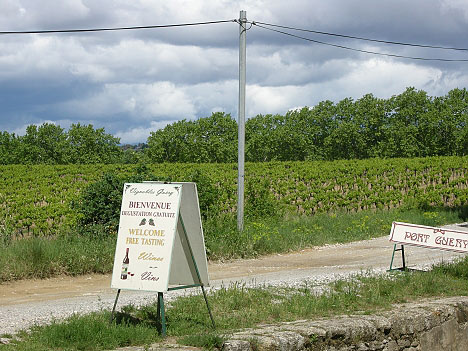 |
| One of the sparse invitations to wine tastings |
South of us, too, lies a very special wine region, "La Clape". Although it belongs to the Coteaux du Languedoc, it has its own character: wild, austere, volcanic, exposed to the wind, a small mountain range close to the sea. La Clape is about 15 km south of the canal, but the mountain range is easily recognisable. So: now the typical Languedoc style (with its own Clape character) comes to the table. I want to feel the rocks, the sea. "La Falaise" from the Châteaux de la Négly. Falaise means rock face, cliff, steep coast. The wine does indeed have some of this character, but embedded in a soft, fine, fresh-smelling bouquet, in a variety of aromas that must have absorbed the whole Languedoc, from the flowers and berries to the garrigue fields and stone soils.
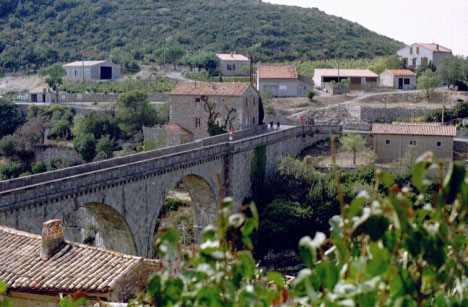 |
| Unreachable from the boat% Minerve at the foot of the "black mountains" |
At last, our boat penetrates one of the most independent appellations of the great wine region, Minervois-la-Livinière. Here the canal is already 33 m.a.s.l. To the north, the terraces of the Minervois can be seen, stretching from the Black Mountains almost to the canal. We cannot (unfortunately) see Minerve, the historic (Cathar) "rock nest" high above the River Brian, it is 15 km to the north. But we do see vineyards, vineyards, vineyards.... Our wine: "Fontaine de Cathala" from Château Gourgazaud, at the foot of the "Black Mountain": a soft, fine, delicate Minervois, a Cabernet, therefore "only" a "Vin de Pays d'Oc" (the Minervois appellation does not allow the grape variety Cabernet Sauvignon). Perhaps we should have uncorked the somewhat wild "Carignanissime" from Clos Centeilles first, a "pure" Carignan that so aptly characterises the landscape. Both wines show the wide spectrum of wines in the Minervois: from independent, untamed, special, characteristic in the case of Carignan to the rather binding, full, cassis-like Cabernet.
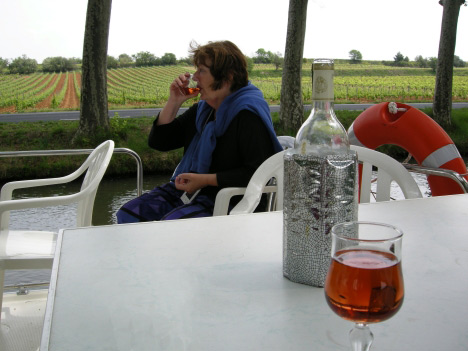 |
| A cool rosé by day |
We gradually approach Carcassonne, moving over long distances between the largest and hottest wine region, the Corbière in the south and the Minervois in the north. The Corbière accompanies us for a long time, almost to the Cathar city of Carcassonne.
Finally, a wine from this region, from "Fitou", a smaller wine region that lies in the middle of the Corbière (but south of us). From the Domaine Bertrand-Bergé comes the cuvée "Jean Sirven", so to speak the crowning glory of the good wines the Languedoc has offered us so far. I leave (almost) every Bordeaux behind, I go from one "wow" to the next. Although entirely vinified in barriques (which I don't usually appreciate much in Languedoc wines), it is made from the oldest vines of the estate: Carignan, Syrah and Grenache. A wonderful nose, an almost endless finish, a hint of cassis and liquorice alongside the aromas of the Languedoc wines.
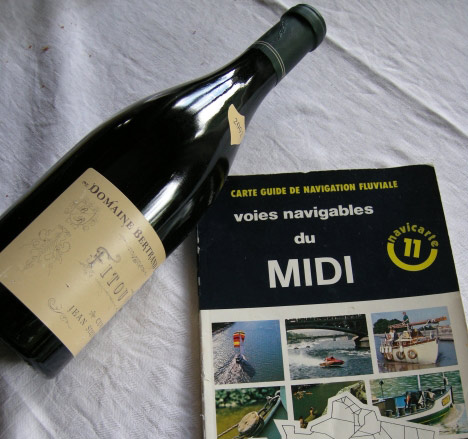 |
| A great red late in the evening: "Jean Sirven" from Bertrand-Bergé% Fitou |
There, yes there, I fell in love, fell in love again, not only with the landscape we were so leisurely crossing, but also with the wines of this landscape. Certainly not all of them. But with the good ones, the particularly good ones, which are available here in an unbelievable variety!
Sincerely
Yours
Peter (Züllig)